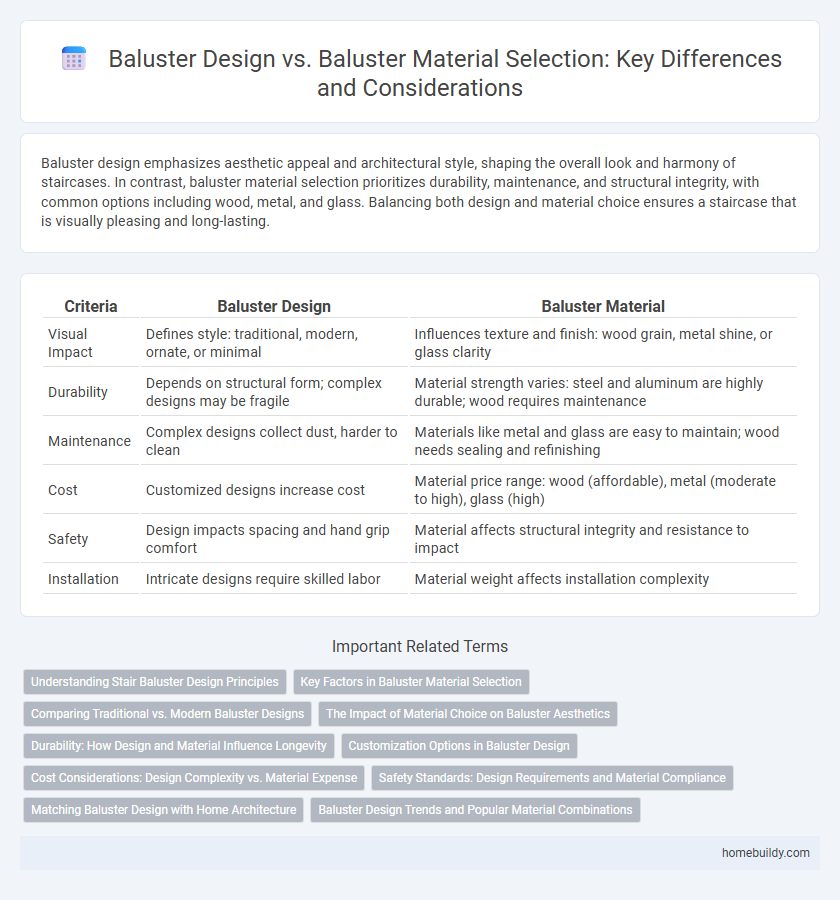Baluster design emphasizes aesthetic appeal and architectural style, shaping the overall look and harmony of staircases. In contrast, baluster material selection prioritizes durability, maintenance, and structural integrity, with common options including wood, metal, and glass. Balancing both design and material choice ensures a staircase that is visually pleasing and long-lasting.
Table of Comparison
| Criteria | Baluster Design | Baluster Material |
|---|---|---|
| Visual Impact | Defines style: traditional, modern, ornate, or minimal | Influences texture and finish: wood grain, metal shine, or glass clarity |
| Durability | Depends on structural form; complex designs may be fragile | Material strength varies: steel and aluminum are highly durable; wood requires maintenance |
| Maintenance | Complex designs collect dust, harder to clean | Materials like metal and glass are easy to maintain; wood needs sealing and refinishing |
| Cost | Customized designs increase cost | Material price range: wood (affordable), metal (moderate to high), glass (high) |
| Safety | Design impacts spacing and hand grip comfort | Material affects structural integrity and resistance to impact |
| Installation | Intricate designs require skilled labor | Material weight affects installation complexity |
Understanding Stair Baluster Design Principles
Stair baluster design principles emphasize both aesthetics and structural integrity, requiring careful selection of materials that complement the overall architectural style while ensuring durability. Common baluster materials such as wood, metal, and glass each offer distinct visual and performance characteristics that influence design decisions, including weight support and maintenance requirements. Understanding the interaction between baluster design elements and material properties is crucial for achieving a harmonious, safe, and long-lasting staircase feature.
Key Factors in Baluster Material Selection
Baluster material selection significantly impacts durability, maintenance, and aesthetic appeal, with common options including wood, metal, glass, and composite materials. Key factors influencing material choice encompass environmental conditions, structural strength requirements, cost considerations, and compatibility with overall design themes. Selecting the appropriate material ensures long-lasting performance while complementing the baluster design and staircase architecture.
Comparing Traditional vs. Modern Baluster Designs
Traditional baluster designs often feature intricate wood or wrought iron craftsmanship, emphasizing ornate details and classical aesthetics ideal for period homes, while modern baluster designs prioritize sleek, minimalist forms crafted from materials like stainless steel, glass, or cable for a clean, contemporary look. Material selection directly impacts both visual style and durability; wood offers warmth and easy customization but requires maintenance, whereas metal and glass provide longevity and a streamlined appearance suited to modern interiors. Choosing between traditional and modern balusters involves balancing design preferences with material performance to achieve the desired architectural statement and functional resilience.
The Impact of Material Choice on Baluster Aesthetics
Baluster material selection significantly influences the overall aesthetics, with choices ranging from classic wood offering warmth and traditional charm to sleek metal providing a modern, industrial look. Materials like wrought iron allow for intricate designs that enhance visual interest, while glass balusters create a contemporary, open feel that maximizes light flow and space perception. Understanding the interaction between material properties and design intricacies is essential for achieving a cohesive and visually appealing staircase.
Durability: How Design and Material Influence Longevity
Baluster design significantly impacts durability by determining structural stability and load distribution, with designs such as classic turned or square balusters offering different strengths. Material selection, including hardwoods like oak or metal options such as wrought iron, influences resistance to wear, moisture, and environmental stress. Combining a well-engineered design with high-quality, durable materials ensures prolonged longevity and reduced maintenance for stair balusters.
Customization Options in Baluster Design
Baluster design customization offers a variety of styles, including traditional, modern, and ornate patterns that enhance stair aesthetics while complementing architectural themes. Material selection such as wood, metal, glass, or composite influences durability, maintenance, and visual appeal, allowing homeowners to tailor balusters to specific functional and stylistic needs. Combining design and material customization expands creative possibilities, enabling unique staircases that reflect personal taste and meet building codes.
Cost Considerations: Design Complexity vs. Material Expense
Baluster design complexity significantly influences overall project costs, with intricate patterns requiring skilled labor that increases installation expenses. Material selection also plays a crucial role, as premium materials like wrought iron or exotic hardwoods drive up the budget compared to standard options such as pine or metal alloys. Balancing ornate design with economical material choices can optimize cost efficiency without compromising aesthetic appeal in stair baluster installations.
Safety Standards: Design Requirements and Material Compliance
Baluster design must adhere to stringent safety standards ensuring proper spacing and height to prevent falls or entrapment, with a maximum gap of 4 inches as mandated by the International Residential Code (IRC). Material selection plays a critical role in maintaining structural integrity and durability, requiring compliance with ASTM standards for load resistance and fire retardancy, often favoring steel, hardwood, or reinforced composite materials. Ensuring both design and material compliance guarantees balusters provide optimal safety in residential and commercial staircases.
Matching Baluster Design with Home Architecture
Selecting baluster design should prioritize harmony with the home's architectural style to enhance overall aesthetic appeal. Modern homes benefit from sleek metal balusters while traditional residences are better complemented by intricately carved wooden balusters. Material choice directly impacts durability and maintenance, but seamless integration with architectural elements like stair railings and flooring ensures a coherent and visually striking staircase.
Baluster Design Trends and Popular Material Combinations
Baluster design trends emphasize sleek, minimalist lines paired with intricate patterns that enhance modern architectural styles. Popular material combinations include wrought iron with wood for a warm yet sturdy aesthetic, and glass paired with stainless steel to create an open, contemporary look. These combinations not only support structural integrity but also elevate visual appeal in both residential and commercial staircases.
baluster design vs baluster material selection Infographic

 homebuildy.com
homebuildy.com